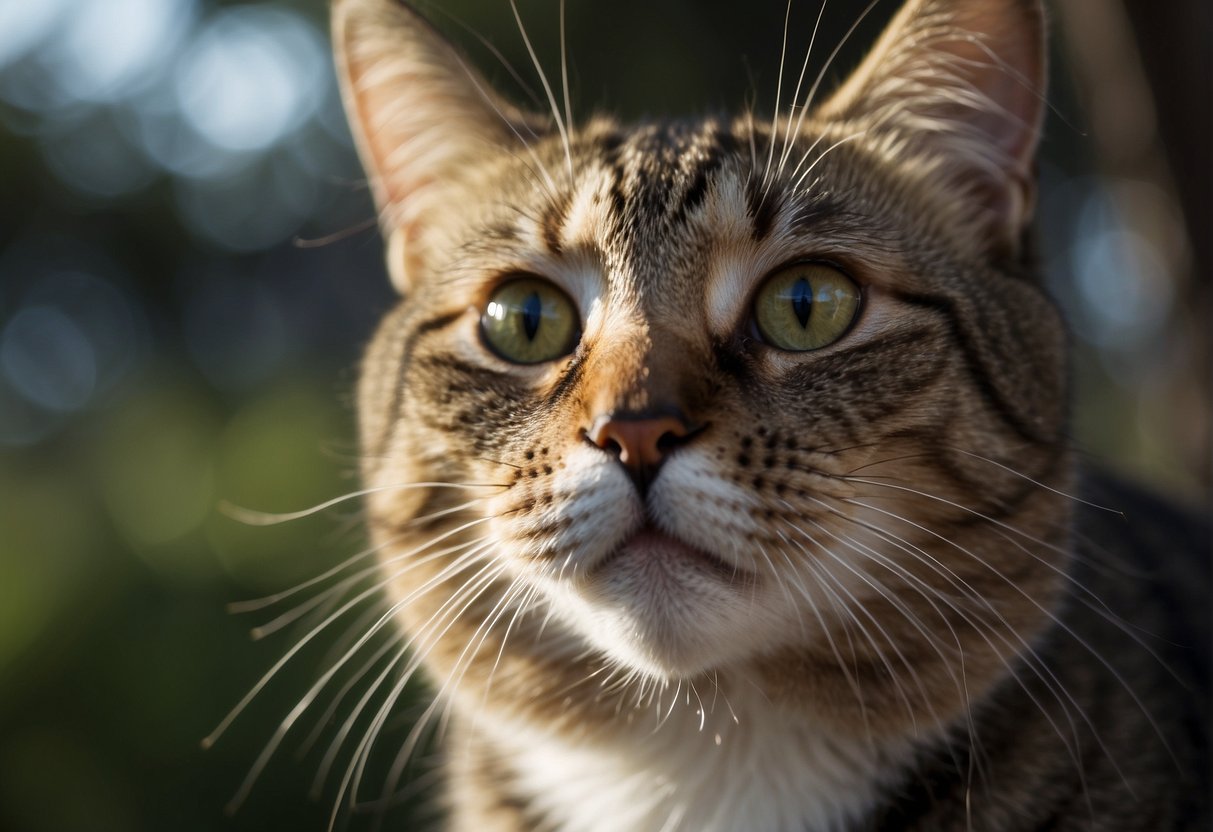If your cat’s meow has gone from a full-bodied chorus to a hoarse whisper or has disappeared entirely, it may be cause for concern.
Cats can lose their voice just like humans, often due to a bout of laryngitis or an upper respiratory infection.
I remember when my own furry friend suddenly stopped serenading me with his usual vocal antics; it turned out he had a mild cold that affected his voice box but thankfully, it wasn’t anything serious.
Monitoring your cat for additional symptoms, such as coughing, wheezing, or changes in behavior, is essential. These could be clues pointing towards an infection, an allergic reaction, or something more severe that requires immediate attention.

Understanding Cat Laryngitis
When your cat suddenly stops meowing or its voice becomes unusually hoarse, it could be a sign of laryngitis, a condition that requires prompt attention to alleviate discomfort and prevent more serious complications.
Identifying Symptoms
- Hoarseness or Loss of Voice: Your cat’s meows may sound different, or it may lose its voice entirely.
- Coughing: A persistent, painful cough can be a symptom of throat inflammation.
- Swallowing Difficulties: Watch for signs of trouble eating or swallowing, which could indicate laryngeal discomfort.
- Difficulty Breathing: In severe cases, a cat might display labored breathing due to narrowed airways.
Exploring Causes
A variety of factors can lead to cat laryngitis, some of which are outlined below:
- Infection: Upper respiratory infections are common culprits behind the inflammation of a cat’s larynx.
- Inflammation: Causes range from allergies to more serious conditions like eosinophilic granuloma complex.
- Laryngeal Paralysis: Nerve damage or cartilage problems in the larynx can lead to voice changes.
- Trauma or Stress: Physical injury or emotional stress can adversely affect your cat’s vocal cords.
- Health Conditions: Hyperthyroidism, tumors, and even throat cancer should be considered if vocal changes persist.
Seeking Veterinary Diagnosis and Treatment
When your cat’s meow turns into a whisper, it’s important to understand when to seek veterinary help, the types of treatments available, and what home care strategies you can employ to aid in their recovery.
When to Visit the Vet
If you notice a change in your cat’s voice or if they’re having difficulty swallowing, a prompt visit to the vet is warranted. It could be a sign of a respiratory infection or other conditions that may require diagnosis and treatment.
- Respiratory Infection: Look for symptoms like coughing, sneezing, or discharge from the eyes or nose.
- Difficulty Breathing: Any signs of labored breathing are a red flag and need immediate attention.
- Changes in Behavior: Reduced energy level or appetite, increased vomiting, or any abrupt changes in their usual routine are cues to seek veterinary expertise.
Potential Treatments
After a thorough evaluation, your vet may recommend a treatment plan that could include:
- Medication: Your cat might need antibiotics for an infection or anti-inflammatory drugs.
- Surgery: In cases where there’s a foreign object or other obstructions, surgery might be necessary.
- Diet Adjustments: Your vet might suggest dietary changes or supplements to bolster your cat’s immune system.
Home Care Strategies
Alongside professional treatment, there are steps you can take to comfort your feline friend:
- Humidifier: Using a humidifier in the room where your cat sleeps can help soothe their throat.
- Quiet Environment: Providing a peaceful, low-stress environment can be beneficial for recovery.
- Monitor Eating and Drinking: Ensure they continue to drink water and eat, even if you have to offer soft or wet food.
Preventing Voice Loss in Cats
Addressing the daily needs of your cat as well as the health risks they might face, you can promote a lifestyle that supports their vocal health. Let’s get into what some of those daily tasks look like.
Daily Care and Lifestyle Changes
Daily care is fundamental in maintaining your cat’s vocal health. A few lifestyle adjustments can go a long way:
- Enrichment: Engage your cat in regular playtime to ensure that they stay active and maintain a healthy energy level. This helps in reducing stress, which can lead to various health issues.
- Diet: Provide a balanced diet to support your cat’s immune system. Adequate nutrition is crucial in preventing illnesses that could affect their voice, such as respiratory infections.
- Humidifier: Consider using a humidifier in dry environments to add moisture to the air. It can help soothe and prevent irritation of your cat’s throat and vocal cords.
- Quiet Space: Create a quiet and comfortable rest area for your cat to relax. Cats are emotional creatures, and excessive noise or disruptions can cause stress.
Understanding Potential Health Risks
Being aware of potential health risks enables you to react promptly:
- Respiratory Disease: Keep an eye out for signs of respiratory diseases. Symptoms like coughing or wheezing could indicate an underlying condition affecting your cat’s voice.
- Immunization: Ensure that your cat’s vaccinations are up to date, reducing the risk of infections that could lead to voice loss.
- Regular Vet Check-ups: Routine vet examinations can help detect early signs of tumors, growths, or cancerous polyps that could affect your cat’s larynx.
- Understanding Laryngeal Paralysis: A rare but serious condition, laryngeal paralysis can lead to voice loss. Knowing the symptoms, such as changes in voice and breathing difficulty, allows for timely veterinary intervention.
Supporting Recovery and Monitoring Progress
When your cat’s voice isn’t at its best, a structured plan for monitoring recovery and providing follow-up care is essential. These efforts help ensure that your cat regains its vocalizations and resumes a normal lifestyle.
Monitoring Your Cat’s Recovery
Key Observations:
- Watch for improvements or changes in your cat’s voice.
- Note whether vocalizations return to normal levels of frequency and tone.
Action Steps:
- Record details: Keep a daily log of any vocal sounds your cat makes.
- Listen for hoarseness or absence of meowing and purring.
- Monitor behavior: Your cat’s overall demeanor can be indicative of recovery.
Appointments:
- Schedule follow-up visits with your veterinarian to assess larynx health.
- Verify if further veterinary care or medication is required.
Follow-Up Care and Attention
Home Environment:
- Maintain a stress-free environment to support healing.
- This includes reducing loud noises and maintaining a comfortable living space.
- A humidifier can soothe the larynx and aid recovery.
Treatment and Medication:
- Continue any prescribed treatment or medication exactly as directed by your vet.
- Understand when and how to administer medication.
- Don’t hesitate to ask your vet for a demonstration if you’re unsure.
Communication with Your Vet:
- Keep open communication with your vet, reporting any concerns or progress.
- Ask questions about your cat’s lifestyle changes that may enhance recovery, such as dietary adjustments.

My name is James, and welcome to FAQCats!
Along with our team of cat owners, expert pet enthusiasts, and pet professionals, we aim to write engaging helpful, engaging content about cats. At FAQCats we strive to provide content that’s accurate and fun to read. Our team writes about everything related to cats; even the most complex of topics. Through extensive research and caring for our own fur-pals, we’re able to provide something cat owners worldwide will love. Have a look around, and leave us feedback anytime!

